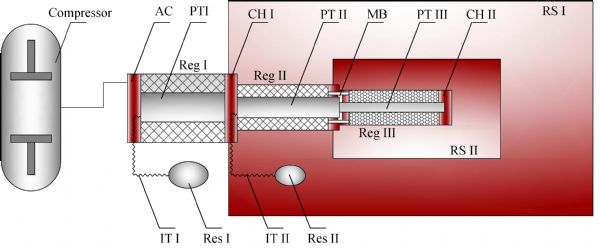 PDF(2371 KB)
PDF(2371 KB)


Performance improvement of a pulse tube cryocooler with a single compressor through cascade utilization of cold energy
 PDF(2371 KB)
PDF(2371 KB)
 PDF(2371 KB)
PDF(2371 KB)
Performance improvement of a pulse tube cryocooler with a single compressor through cascade utilization of cold energy
The high-frequency pulse tube cryocooler (HPTC) has been attracting increasing and widespread attention in the field of cryogenic technology because of its compact structure, low vibration, and reliable operation. The gas-coupled HPTC, driven by a single compressor, is currently the simplest and most compact structure. For HPTCs operating below 20 K, in order to obtain the mW cooling capacity, hundreds or even thousands of watts of electrical power are consumed, where radiation heat leakage accounts for a large proportion of their cooling capacity. In this paper, based on SAGE10, a HPTC heat radiation calculation model was first established to study the effects of radiation heat leakage on apparent performance parameters (such as temperature and cooling capacity), and internal parameters (such as enthalpy flow and gas distribution) of the gas-coupled HPTC. An active thermal insulation method of cascade utilization of the cold energy of the system was proposed for the gas-coupled HPTC. Numerical simulations indicate that the reduction of external radiation heat leakage cannot only directly increase the net cooling power, but also decrease the internal gross losses and increase the mass and acoustic power in the lower-temperature section, which further enhances the refrigeration performance. The numerical calculation results were verified by experiments, and the test results showed that the no-load temperature of the developed cryocooler prototype decreased from 15.1 K to 6.4 K, and the relative Carnot efficiency at 15.5 K increased from 0.029% to 0.996% when substituting the proposed active method for the traditional passive method with multi-layer thermal insulation materials.

radiation heat leakage / active thermal insulation / cascade utilization / cold energy / performance improvement / cryocooler
| [1] |
Dang H, Bao D, Gao Z,
CrossRef
ADS
Google scholar
|
| [2] |
El-Ghafour S A, El-Ghandour M, Mikhael N N. Three-dimensional computational fluid dynamics simulation of stirling engine. Energy Conversion and Management, 2019, 180: 533–549
CrossRef
ADS
Google scholar
|
| [3] |
Caetano B, Lara I, Borges M, Sandoval O R,
CrossRef
ADS
Google scholar
|
| [4] |
Collaudin B, Rando N. Cryogenics in space: a review of the missions and of the technologies. Cryogenics, 2000, 40(12): 797–819
CrossRef
ADS
Google scholar
|
| [5] |
Nast T, Olson J, Champagne P,
|
| [6] |
Radebaugh R. Cryocoolers: the state of the art and recent developments. Journal of Physics Condensed Matter, 2009, 21(16): 164219
CrossRef
ADS
Pubmed
Google scholar
|
| [7] |
Narasaki K, Tsunematsu S, Kanao K,
CrossRef
ADS
Google scholar
|
| [8] |
Bradley P E, Radebaugh R, Garaway I,
|
| [9] |
Wang B, Gan Z. A critical review of liquid helium temperature high frequency pulse tube cryocoolers for space applications. Progress in Aerospace Sciences, 2013, 61: 43–70
CrossRef
ADS
Google scholar
|
| [10] |
Radebaugh R, Huang Y, O'Gallagher A,
CrossRef
ADS
Google scholar
|
| [11] |
Cao Q, Li Z, Luan M,
CrossRef
ADS
Google scholar
|
| [12] |
Qiu L, Cao Q, Zhi X,
CrossRef
ADS
Google scholar
|
| [13] |
Zhi X, Han L, Dietrich M,
CrossRef
ADS
Google scholar
|
| [14] |
Qiu L, Han L, Zhi X,
CrossRef
ADS
Google scholar
|
| [15] |
Chen L, Wu X, Wang J,
CrossRef
ADS
Google scholar
|
| [16] |
Liu X, Chen L, Wu X,
CrossRef
ADS
Google scholar
|
| [17] |
Qiu L, Zhi X, Han L,
CrossRef
ADS
Google scholar
|
| [18] |
Pang X, Wang X, Dai W,
|
| [19] |
Dang H, Bao D, Zhang T,
CrossRef
ADS
Google scholar
|
| [20] |
Chen L, Jin H, Wang J,
CrossRef
ADS
Google scholar
|
| [21] |
Chen L, Zhou Q, Jin H,
CrossRef
ADS
Google scholar
|
| [22] |
Pang X, Wang X, Dai W,
CrossRef
ADS
Google scholar
|
| [23] |
Wang N, Zhao M, Ou Y,
CrossRef
ADS
Google scholar
|
| [24] |
Dang H. 40 K single-stage coaxial pulse tube cryocoolers. Cryogenics, 2012, 52(4–6): 216–220
CrossRef
ADS
Google scholar
|
| [25] |
Wu X, Chen L, Liu X,
CrossRef
ADS
Google scholar
|
| [26] |
Chen L, Wu X, Liu X,
CrossRef
ADS
Google scholar
|
| [27] |
Radebaugh R. Thermodynamics of regenerative refrigerators. In: Ohtsuka T, Ishizaki Y, eds. Generation of Low Temperature and Its Application, 2003: 1–20
|
| [28] |
Gedeon D. Sage User’s Guide: Stirling, Pulse-Tube and Low-T Cooler Model Classes. Gedeon Associates, Athens, OH, USA, 2014
|
| [29] |
Wu Y. Theoretical and experimental study on a single stage pulse tube cryocooler operating at 120 Hz (in Chinese). Dissertation for Master’s Degree. Hangzhou: Zhejiang University, 2010 (in Chinese)
|
| [30] |
Wang L. Theoretical and experimental investigations on the geometrical parameters and key structures of high frequency pulse tube cryocoolers. Dissertation for Doctoral Degree. Shanghai: Shanghai Institute of Technical Physics, Chinese Academy of Sciences, 2012 (in Chinese)
|
| [31] |
Zheng J, Chen L, Liu X,
CrossRef
ADS
Google scholar
|
/
| 〈 |
|
〉 |